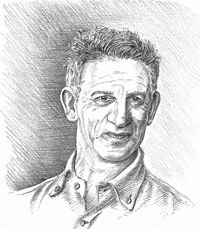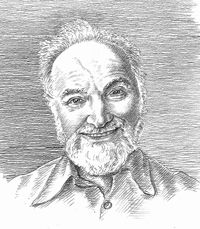Birth of a Theorem: A Mathematical Adventure (19 page)
Read Birth of a Theorem: A Mathematical Adventure Online
Authors: Cédric Villani
Tags: #Non-Fiction, #Science, #Biography


Peter Sarnak
“Cohen didn’t believe in incremental mathematics.”
“Incremental?”
“Yes, he thought that mathematics progresses by sudden leaps. You and me, like everyone else, nudge it forward by improving on the work of others, but not Cohen! If you told him you were improving something he’d send you packing. He believed in revolutions and nothing else!”
Always a pleasure listening to Peter. Also at our table was the young Israeli mathematician Emanuel Milman, a rising star of convex geometry whose office is right next to mine. Emanuel is the son, nephew, and grandson of mathematicians. Recently he became a father. Of a future mathematician? Certainly he speaks with no less delight about his wonderful child than about his own work.
Seated next to Emanuel was Sergiu Klainerman, who fled Communist Romania in the 1970s. Sergiu achieved worldwide fame when, together with the phenomenal Greek mathematician Demetri Christodoulou, he established a fundamental result of general relativity in an epic five-hundred-page proof. I very much enjoy discussing mathematics, politics, and ecology with Sergiu, subjects on which we often disagree.…
By no means the least of the reasons why the conversation at our table was so animated was the legendary verve of Joel Lebowitz, who, despite his advancing years, has still got way more energy than people half his age. Joel is interested in everything, wants to know everything, and if you get him talking about his favorite subject, statistical physics, he can go on forever.
I took advantage of Joel’s presence to ask him to tell Emanuel about the difficulties involved in explaining phase transitions for a hard sphere gas. Simple to state, of fundamental importance, and yet the problem has baffled statistical physicists for more than fifty years now. I mean, really, here we are today, in 2009, and
still
we haven’t managed to penetrate the mysteries of a state change—why a liquid is transformed into a gas when it is heated, why it is transformed into a solid when it is cooled! Who knows, a really smart young guy like Emanuel just might have a new idea.…

Joel Lebowitz
No sooner had the lunch break come to an end than all my nagging worries came flooding back. There are still some administrative questions to be settled with the Institut Poincaré, or rather the question of my association with ENS-Lyon, which I would like to maintain while at the same time fulfilling my duties as director in Paris. At the lab in Lyon my great pal Alice Guionnet has my back while I’m gone, but everything is so complicated.… Then there’s the series of talks I’ve got to prepare. And then there’s the most important thing of all, the Landau damping proof, which still doesn’t want to come together! Over the past ten days Clément and I have drafted ten new versions of our article, the latest one is number 36 and runs to one hundred thirty pages. We’ve spotted and corrected a number of errors and added a very instructive section of counterexamples. Another one of my colleagues in Lyon, Francis Filbet, has provided us with marvelous computer-generated images of Landau damping as well. But there’s still so much to do! A voice in my head echoes softly:
We’ve got to refine the estimates on the characteristics and get the supremum inside the norm, concentrate on the @!*# Coulomb interactions, add a Sobolev regularity correction index more or less everywhere (seven indices—
porca miseria!
), keep the exponential stratification along the Newton scheme, get the huge recurrence going round and round.…
My big mistake was to let the indefatigable Joel drag me into a working session with another French mathematician. Before long I found myself overwhelmed by a sense of desperation. There are so many things I should be focusing on; for the last several days I’ve been working until two in the morning … in the haze of my après-lunch torpor I was scarcely able even to collect my thoughts. Impossible to say no to Joel—but seeing that the session was going to drag on and on, I broke down and resorted to a shameful piece of subterfuge: Sorry, I’ve got to go now, got to pick up the kids from school (when today that was actually their mother’s job). I hid outside until the two of them had gone down the hall to work in another room, then crept back into my office, lay down on the bare floor, and went to sleep so that my poor overtaxed brain could have a moment’s rest.
Soon I was awake again and back to work at once.
* * *
Paul Cohen, briefly Nash’s younger colleague and ambitious rival at MIT in the late 1950s, was one of the most creative minds of the twentieth century. His greatest claim to fame is the solution of the continuum hypothesis (also known as the problem of the intermediate cardinal). This enigma, the first of the twenty-three outstanding problems stated by Hilbert in 1900, was still considered one of the most important challenges in mathematics more than a half century later. Anyone who could solve it was obviously in line for a Fields Medal, duly awarded to Cohen in 1966.
To understand the continuum hypothesis, it will be helpful to keep a few things in mind. The whole numbers
(1, 2, 3, 4…)
are, of course, infinite in number. The fractional numbers
(1/2, 3/5, 4/27, 53417843/14366532,…)
are infinite as well. It seems as though fractional numbers must be more numerous than whole numbers, but this is an illusion: one can enumerate the fractions, for example
1, 1/2, 2/1 [
=
2], 1/3, 3, 1/4, 2/3, 3/2, 4, 1/5, 5, 1/6, 2/5, 3/4, 4/3, 5/2, 6,…
by gradually increasing the sum (numerator
+
denominator)—as Ivar Ekeland explains so well in his delightful children’s story,
The Cat in Numberland.
Therefore there aren’t more fractional numbers than whole numbers, there are exactly as many of the one kind as of the other.
But if we consider the so-called real numbers—those numbers that can be written down only with an infinite number of decimal places (which are also the limits of fractional numbers)—then, thanks to a magnificent argument devised by Cantor, we see that there are many more reals. Indeed, there are uncountably many of them.
We therefore have an infinite quantity of whole numbers (or integers), and a still greater infinite quantity of real numbers. So, is there an infinity that is both greater than the infinity of the integers and smaller than the infinity of the reals? Mathematical logicians worked on the problem for decades, some trying to show that yes, this intermediate infinity does exist; others, to the contrary, that no, it doesn’t exist. But to no avail.
Paul Cohen wasn’t a logician by training, but he believed in his own brainpower. To everyone’s amazement he succeeded in showing that the answer is neither yes nor no: there does exist a mathematical world that has an intermediate infinity, yet there also exists a mathematical world that does not have one—and it is up to us to choose which world we want. Either one will be correct, if it is the one we want. Determining which world is the more natural of the two remains an open problem in set theory still today.
* * *
Joel Lebowitz is the high priest of statistical physics, the branch of science that seeks to discover the properties of systems consisting of very large numbers of particles. Gases made up of billions of billions of molecules, biological populations made up of millions of individuals, galaxies made up of hundreds of billions of stars, crystalline lattices made up of billions of billions of atoms—statistical physics covers a lot of territory! And for almost sixty years Joel has put his inexhaustible energy in the service of an unequaled passion for the subject, tirelessly working with his fellow mathematicians and physicists. The semiannual series of conferences he inaugurated in 1958 is probably the oldest meeting organized by an active scientist today. I doubt any other meeting has welcomed more participants over the years.
Born in Czechoslovakia nearly eighty years ago, Joel has had such a full life, full of good and bad memories both. A number is tattooed on his forearm; he never speaks of it. No matter what the occasion, Joel is the first one to laugh, the first one to hoist a glass, and, of course, the first one to talk about statistical physics—as though it were a vast musical composition whose every theme he has set out to explore, playing in every key. The amount of energy a person has ought to be measured in “milli-Joels,” thousandths of Joel, as one of our colleagues wittily suggested: a thousandth of Joel’s energy is still a good amount. Maybe even “pico-Joels,” come to think of it!
* * *
Date: Mon, 9 Mar 2009 21:42:10
+
0100
From: Francis FILBET
To: Cedric Villani
Cc: Clement Mouhot
Hello
Here’s what I was able to work up over the weekend. Short films, no big deal (not on a level with Desplechin): in the part about numerical simulations of charged particle systems.
http://math.univ-lyon1.fr/~filbet/publication.html
This is the plasma case. I haven’t changed the sign for the gravity case yet I’m very surprised by what you say. I think that a neutralizing background is needed to keep a periodic potential i.e. \int_0^L E(t,x)dx
=
0 when one has periodic boundary conds
Date: Mon, 9 Mar 2009 22:11:10 -0500
From: Cedric Villani
To: Francis FILBET
Cc: Clement Mouhot
The images are superb! It’s really moving to see equations on which one has worked “in the abstract” brought to life, made real.…
Cedric
Princeton
March 13, 2009
Closed the door to the kids’ room a moment ago. My daughter was still chuckling about the adventures of Goofy, the hero of tonight’s imaginary story.
Sleep, little wonders, tomorrow day will dawn.
Claire’s in bed, too—last chance to brush up on her Japanese before heading off bright and early tomorrow on a field trip with her research team. Just the right moment for me to get some work done. Made a pot of tea and spread out my drafts on the floor. Still a mountain of technical problems, which Clément and I go on climbing one problem at a time.
Working on section 9 at the moment, the longest section of the proof. There’s this damn control on the zero mode, I knew it was going to drive me crazy. And I’ve got to present the result in ten days! Ten short days to get the whole thing to hang together.
* * *
Date: Fri, 13 Mar 2009 21:18:58 -0500
From: Cedric Villani
To: Clement Mouhot